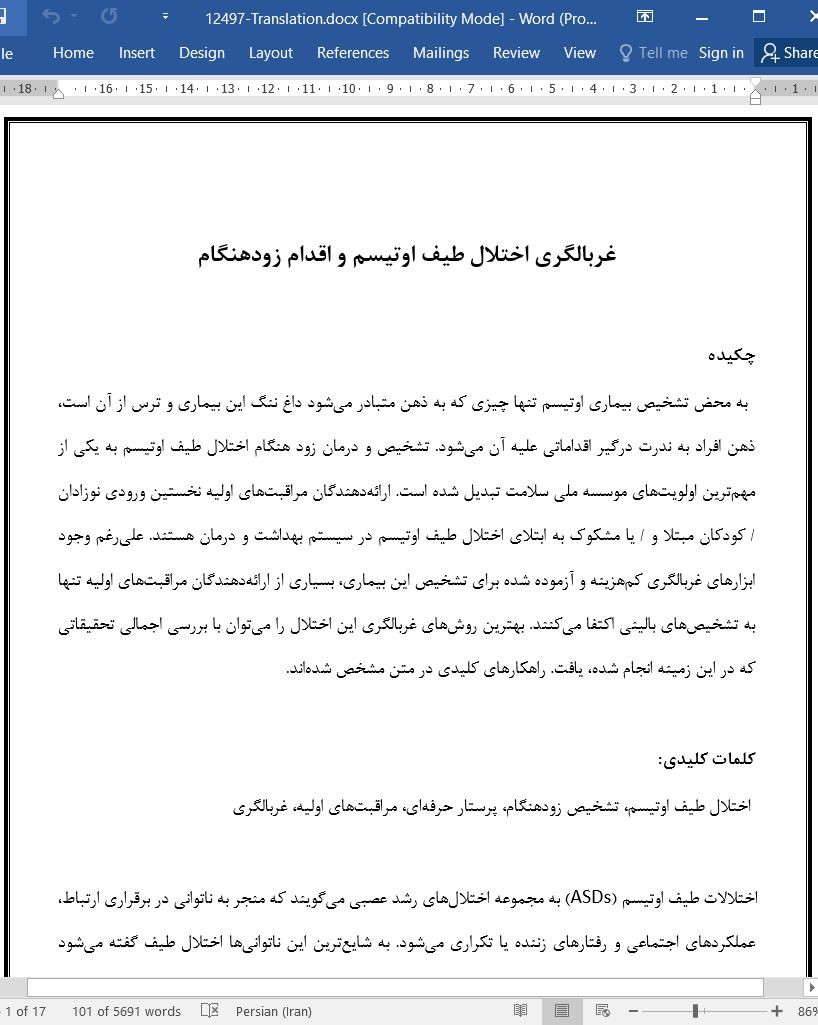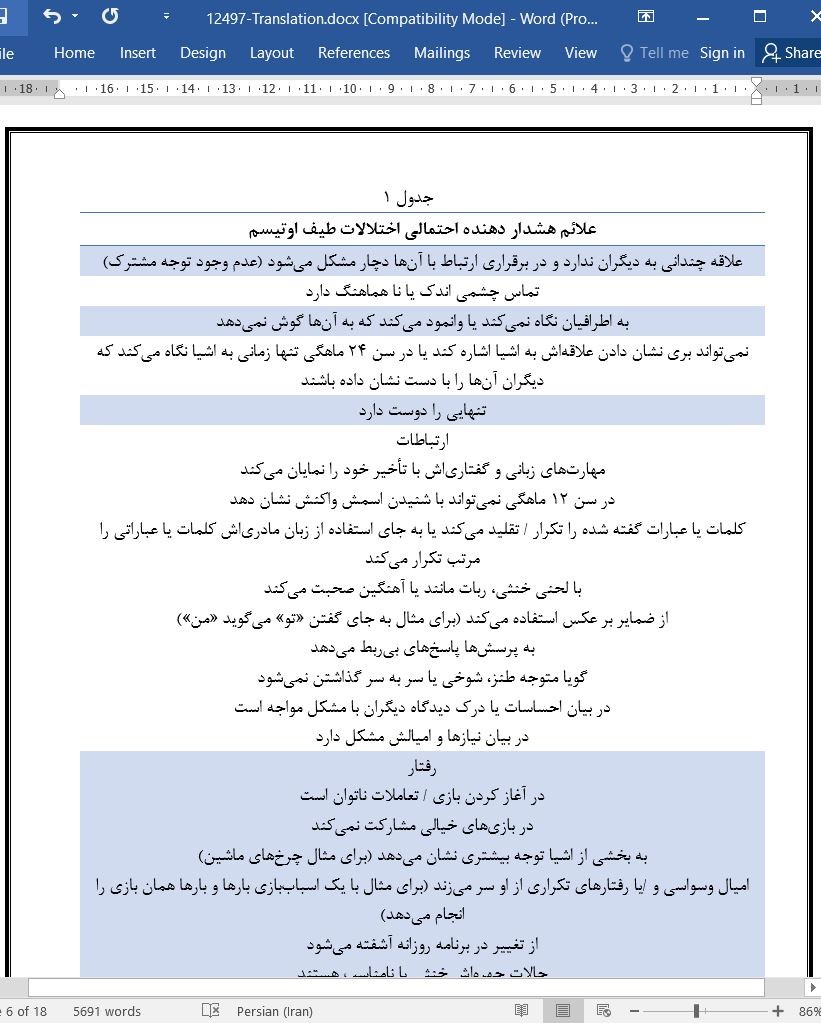
دانلود مقاله غربالگری اختلال طیف اوتیسم و اقدام زودهنگام
چکیده
به محض تشخیص بیماری اوتیسم تنها چیزی که به ذهن متبادر میشود داغ ننگ این بیماری و ترس از آن است، ذهن افراد به ندرت درگیر اقداماتی علیه آن میشود. تشخیص و درمان زود هنگام اختلال طیف اوتیسم به یکی از مهمترین اولویتهای موسسه ملی سلامت تبدیل شده است. ارائهدهندگان مراقبتهای اولیه نخستین ورودی نوزادان / کودکان مبتلا و / یا مشکوک به ابتلای اختلال طیف اوتیسم در سیستم بهداشت و درمان هستند. علیرغم وجود ابزارهای غربالگری کمهزینه و آزموده شده برای تشخیص این بیماری، بسیاری از ارائهدهندگان مراقبتهای اولیه تنها به تشخیصهای بالینی اکتفا میکنند. بهترین روشهای غربالگری این اختلال را میتوان با بررسی اجمالی تحقیقاتی که در این زمینه انجام شده، یافت. راهکارهای کلیدی در متن مشخص شدهاند.
اختلالات طیف اوتیسم (ASDs) به مجموعه اختلال¬های رشد عصبی می¬گویند که منجر به ناتوانی در برقراری ارتباط، عملکردهای اجتماعی و رفتارهای زننده یا تکراری میشود. به شایعترین این ناتوانی¬ها اختلال طیف گفته میشود زیرا افراد مبتلا در طیف گستردهای علائم و شدت این بیماری را از خود بروز میدهند.
در یک سر بردار طیف اوتیسم بیمارانی را داریم که به علت وجود تواناییهای اندک کلامی و هوشی به خدمات ویژهای نیازمند هستند؛ اما در جهت مخالف بردار افرادی را داریم که زندگی روزمره و عادی دارند و از نظر تواناییهای هوشی در حد متوسط و حتی عالی هستند. اکثر افراد مبتلا به ASDs در فضایی مابین دو سر برداری که عرض کردم، قرار میگیرند. با چشم پوشی کردن از این نکته که افراد مبتلا در کجای این بردار قرار میگیرند، هر فردی که مبتلا به طیف اوتیسم است، باید این شانس را داشته باشد تا با شناسایی و درمان زود هنگام بیماری¬اش به موفقیتهایی در زندگی خود دست یابد.
نتیجه
شناسایی زودهنگام ASDs و /یا نگرانیهایی که درباره رشد کودک وجود دارند یکی از پیششرطهای لازم برای درمان زودهنگام است. شواهد نشان دادهاند که درمان زود هنگام احتمالی جلوی رشد مخرب کودک را میگیرد در غیر این صورت شاهد عوارض عصبی بیشتری خواهیم بود؛ بنابراین ارائه برنامههای مفید بلند مدت و کوتاه برای ظرفیتهای انسانی در سیستمها ضروری است. با اینکه لزوماً هر کودکی که مشکلات رشد دارد مبتلا به ASD نیست، اما باز هم نیاز به تشخیص درست دارد، تشخیص و درمان زود هنگام نتایج پربارتری به همراه خواهد داشت.
Abstract
Since its diagnostic inception, autism has garnered stigma and fear, often to the exclusion of action. Early detection and treatment of autism spectrum disorders have become crucial priorities of the National Institutes of Health. The primary care provider is the point of entry to the health care system for infants/children showing risk factors for autism spectrum disorders and/or symptoms of the disorder. Despite the existence of low-cost, well-tested developmental screening tools, many primary care providers rely solely on clinical judgment to ascertain developmental status. Current best screening practices were determined by a review of the literature. Key recommendations are highlighted.
Autism spectrum disorders (ASDs) comprise several complex neurodevelopmental disorders that coalesce around impairments in communicative abilities, social functioning, and rigid or repetitive behaviors. These pervasive disabilities are described as a spectrum disorder because of the considerable variation in how individuals manifest both symptoms and severity.
On one end of the autism spectrum are individuals who need services resulting from co-occurring minimal verbal and intellectual ability. On the opposite end are individuals living near normal lives with average to superior intellectual ability. The majority of people living with ASDs reside somewhere between these extremes. Regardless of where individuals fall, every person on the autism spectrum has a greater chance to achieve life success with early detection and intervention.1
Conclusions
Early detection of ASDs and/or developmental concerns is a prerequisite for early intervention. Increasing evidence supports the potential of early intervention to alter adverse development toward more neurotypical trajectories, thereby providing substantial shortand long-term benefits to human capacity across systems. Although not every child who presents with developmental concerns suggestive of ASD may reach the diagnostic threshold, early detection and intervention offer the best outcomes.32
چکیده
نگرانی بهداشتی فزاینده
مروری بر پیشینه تحقیقاتی
آمایش پیشینه تحقیقاتی
غربالگری ASD
تشخیص رسمی ASD
توصیهها
توصیههایی برای روشهای بالینی
توصیههایی برای آموزش پرستاران
توصیههایی برای تحقیق
توصیههایی برای سیاستگذاری
نتیجه
منابع
Abstract
A Growing Health Concern
Review of the Literature
Synthesis of the Literature
ASD Screening
ASD Formal Diagnosis
Recommendations
Recommendations for Clinical Practice
Recommendations for Nursing Education
Recommendations for Research
Recommendations for Policy
Conclusions
References
- اصل مقاله انگلیسی با فرمت ورد (word) با قابلیت ویرایش
- ترجمه فارسی مقاله با فرمت ورد (word) با قابلیت ویرایش، بدون آرم سایت ای ترجمه
- ترجمه فارسی مقاله با فرمت pdf، بدون آرم سایت ای ترجمه



